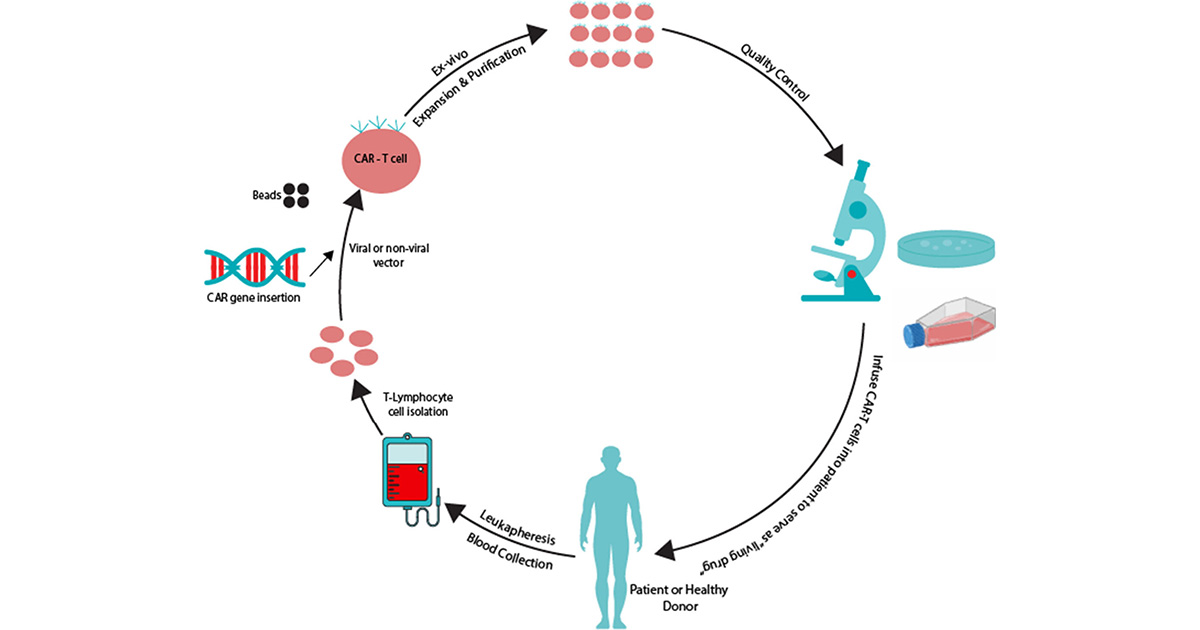

CAR-T cells are lymphocytes modified in the laboratory to fight cancer (image: Journal of Proteome Research)
Researchers at a FAPESP-supported research center have discovered 14 proteins that could be targets for improving CAR-T cell-based therapies.
Researchers at a FAPESP-supported research center have discovered 14 proteins that could be targets for improving CAR-T cell-based therapies.

CAR-T cells are lymphocytes modified in the laboratory to fight cancer (image: Journal of Proteome Research)
Agência FAPESP – A study conducted by researchers at the Center for Cell-Based Therapy (CTC) highlights key proteins and signaling pathways involved in the efficacy of immunotherapy based on CAR-T cells (lymphocytes modified in the laboratory to fight cancer).
The CTC is a Research, Innovation, and Dissemination Center (RIDC) funded by FAPESP and based at the Ribeirão Preto Medical School of the University of São Paulo (FMRP-USP) in Brazil.
The research, published in the Journal of Proteome Research, was carried out by John Oluwafemi Teibo, a doctoral student at FMRP-USP and FAPESP scholarship holder, under the supervision of Professor Vitor Faça.
“CAR-T cell therapy is innovative and has made incredible advances against hematological diseases. There are many CAR-T cell constructs being approved for clinical use. But we don’t fully understand how these CAR-T cells work in terms of molecular mechanisms, or the signaling pathways and molecular effectors involved. And that’s the motivation for this study,” Teibo said in a video published on the São Paulo Blood Center YouTube channel.
The research sought to identify molecular effectors – molecules (usually proteins, but they can also be other molecules) that play a crucial role in responding to stimuli and carrying out specific cellular processes, such as the immune response or signal transduction – related to CAR-T cell therapy in databases such as PubMed and Scopus. The research resulted in the identification of proteins that could be key targets for improving therapy effectiveness.
“We found 14 proteins, which were classified into four categories. First are cytokines, which include interferon, CCL3, gamma interferon, and many others. We also have kinases, such as LCK, ITK, JAK2, as well as B-Raf, and receptors, such as CD80, CD20, which are involved in activating the therapy. Finally, there are proteases and chemical messengers, such as Granzyme B and TNF-α,” said the doctoral student.
The use of proteomics (the analysis of the set of proteins in a sample) will allow for a deeper understanding of changes in these molecules, paving the way for new treatment advances. “For example, we have interferon gamma and also IL2, which can be used as a surrogate biomarker. This could help overcome some of the challenges of CAR-T cell therapy,” said Teibo.
In addition, recent advances in mass spectrometry have made it possible to analyze the abundance, cellular localization, synthesis/degradation, and post-translational modifications of proteins. This allows for a more detailed and integrated understanding of physiological and cellular processes, which is essential for improving therapy.
The article “A Proteomics Outlook on the Molecular Effectors of CAR-T Cell Therapy in Cancer Management” can be read at: pubs.acs.org/doi/full/10.1021/acs.jproteome.4c00930.
Republish
The Agency FAPESP licenses news via Creative Commons (CC-BY-NC-ND) so that they can be republished free of charge and in a simple way by other digital or printed vehicles. Agência FAPESP must be credited as the source of the content being republished and the name of the reporter (if any) must be attributed. Using the HMTL button below allows compliance with these rules, detailed in Digital Republishing Policy FAPESP.





